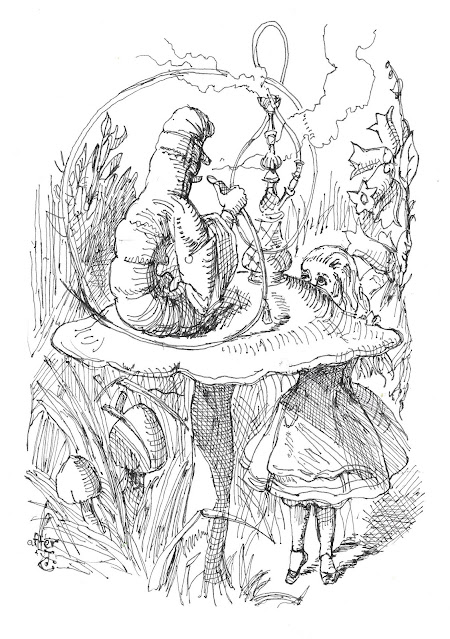Hmm. I’ve not only got stuck on making copes of Tenniel
drawings now, but I’m in a bit of a rut of copying his illustrations from the
Alice books. Still, at least with this one I’ve got away from “Through The
Looking Glass” and I’m on “Alice’s Adventures in Wonderland”.
I don’t think for one minute that the illustration that I’ve
copied here is the finest in the book. However, I’ve copied it because it
depicts possibly my favourite character in the book. I still remember that the
caterpillar fascinated me the first time I ever read the book.
Then, as I grew older, I became aware of some of the more
modern interpretations of the book, ad some of the controversies surrounding
it. The depiction of the caterpillar is one of the features of the narrative
which some commentators have cited as evidence that “Alice’s Adventures In Wonderland”
was at least inspired by the use of mind altering substances. As I read it, the
case for the prosecution relies on two main arguments, one relating toe the
narrative of the book, and the other relating to Lewis Carroll himself.
1) The narrative. There is no
doubt that Alice ingests several substances which change her – a cake, a liquid,
and parts of a mushroom. Then there is the caterpillar. Right at the end of
chapter the caterpillar is introduced in the last couple of sentences - “. . . her eyes immediately met those of a
large blue caterpillar, that was sitting on the top with its arms folded,
quietly smoking a long hookah, and taking not the smallest notice of her or of
anything else.” The at the start of Chapter V the description continues – “The
Caterpillar and Alice looked at each other for some time in silence: at last
the Caterpillar took the hookah out of its mouth, and addressed her in a
languid, sleepy voice.” So, the Caterpillar is smoking an unnamed substance. At
first he seems oblivious to his surroundings, and even when he does notice Alice
he seems sleepy – one might almost say – drugged. Then there is the mushroom.
Certain mushrooms have hallucinogenic properties.
2) Lewis Carroll himself. This
line of argument rests almost entirely on the fact that narcotics – opiates like
laudanum, and cocaine could be obtained from a chemist. So the argument rests
on the fact that Lewis Carroll would not have been committing any crime if
writing “Alice in Wonderland” under the influence of mind altering drugs.
So much for the case for the
prosecution. Let’s begin the defence by looking at the second of the prosecution’s
lines of argument. There is no evidence that Lewis Carroll ever used any
narcotic. He makes no reference to anything of the sort in private letters or
journals – not once. Yes, these things were available to him, but they were
also available to, let’s say, Charlotte Bronte. Nobody would seriously suggest
that “Jane Eyre” was written under the influence
Leading on to the narrative,
if any of the strange occurrences in the story were based on Lewis Carroll’s own
personal experiences at all, then it’s not impossible that the ‘telescoping
Alice’ was inspired by his own experience of Migraine, and what has been diagnosed
as possibly epileptic episodes. Which brings us to the narrative. Despite the
strange things that happen in the story, there is a structure and coherence to
it which I don’t think would have been possible for Carroll to achieve had he
written it under the influence.
Which is not to say that we
can completely exonerate the caterpillar. Certainly with the description I’ve
quoted it’s not impossible to see the Caterpillar as a caricature of of either
an intellectual academic type kidding himself that the habit made him think
more clearly, or maybe a retired colonel from the Indian Army who’d brought the
habit home with him. It’s worth noting, though, that the Caterpillar is the
first of a small number of characters who actually give Alice any useful advice
and render her any practical help. There’s nothing in the caterpillar’s
responses to Alice which you’d necessarily associate with someone under the
influence of drugs either. Yes, he’s a bit brusque, and convinced in the correctness
of his own opinions, but then so probably were a number of the academics
Carroll would have known at Christ Church.
As for the Tenniel illustration,
while I’m fascinated with the Caterpillar in the text, I don’t think it’s one
of his most striking illustrations. It’s a shame, for example, that we never
get to see the Caterpillar’s face. Having said this, though, it does allow
Tenniel to pull off an interesting optical illusion. You look at it, and it’s
possible that you see the Caterpillar holding the mouthpiece of the pipe
towards a mouth between a Mr. Punch nose and chin. Bearing in mind Tenniel’s fifty-year
association with Punch I think that this can only be deliberate. However, if
you look again the chin and the nose could just as easily be his topmost two
legs as well.
------------------------------------------------------
Hmm. I’ve been going on for a
bit longer than I originally planned with his one. I’ll leave it there, and
then in a future post I think I’ll
tackle the elephant in the room (every room, when it comes to discussing Lewis
Carroll) – his relationship with the Liddell girls, and with other children.

No comments:
Post a Comment